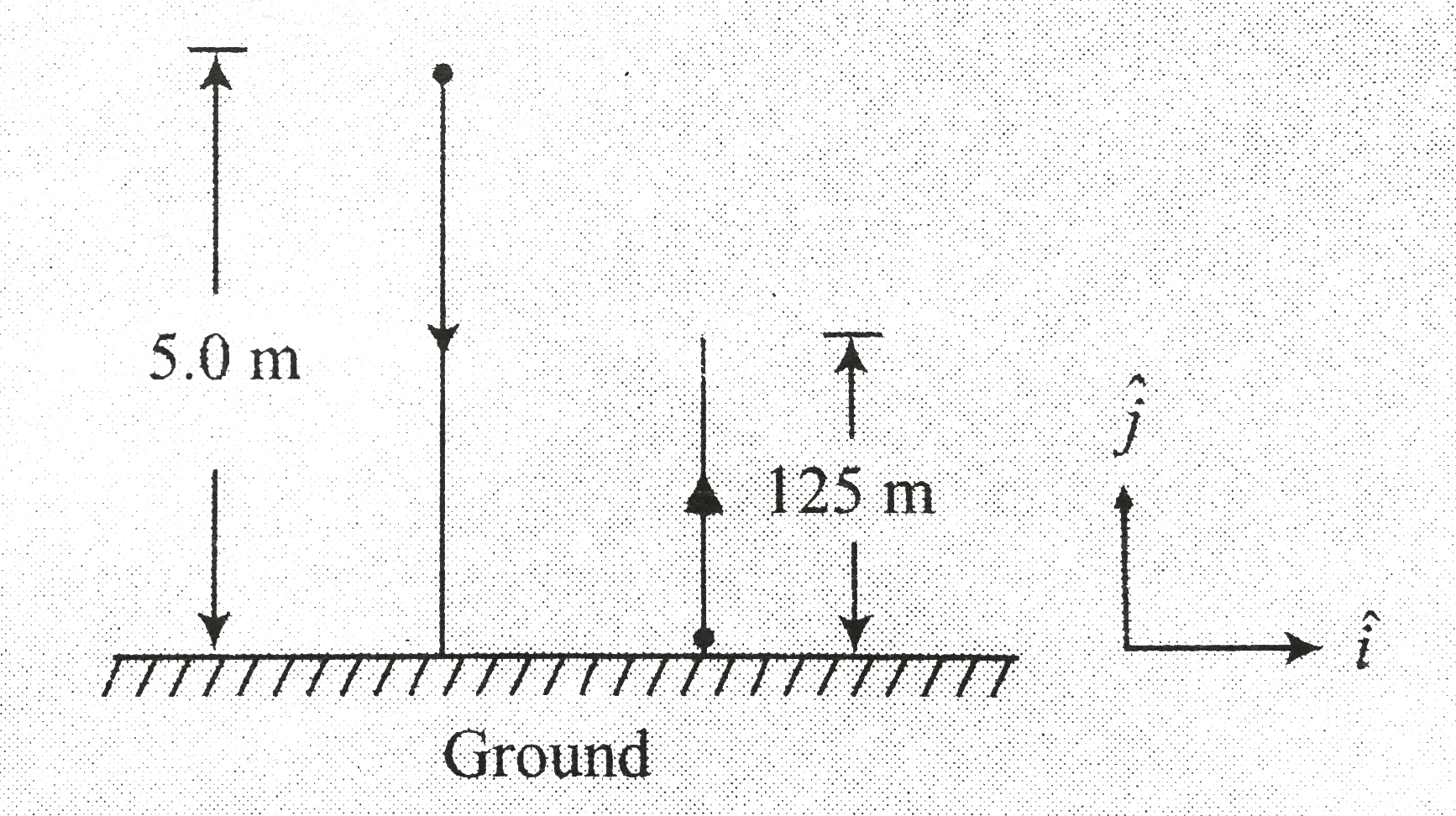A stone of mass falls from the top of a cliff high and buries deep in sand . Find the average resistance offered by the sand and the time it takes to penetrate .
The correct Answer is: .
To solve the problem, we need to find two things: the average resistance offered by the sand and the time it takes for the stone to penetrate 1 meter deep into the sand after falling from a height of 50 meters.
Step 1: Calculate the velocity of the stone just before it hits the sand.
We can use the equation of motion for free fall:
v2=u2+2gh
where:
- v = final velocity (just before hitting the sand)
- u = initial velocity (0 m/s, since it starts from rest)
- g = acceleration due to gravity (approximately 9.81m/s2)
- h = height (50 m)
Substituting the values:
v2=0+2×9.81×50
v2=981
v=√981≈31.32m/s
Step 2: Calculate the deceleration of the stone while penetrating the sand.
When the stone penetrates the sand, it comes to a stop after traveling 1 meter. We can use the equation of motion again:
v2=u2+2as
where:
- v = final velocity (0 m/s, since it comes to rest)
- u = initial velocity (31.32 m/s, just before hitting the sand)
- a = acceleration (deceleration in this case)
- s = distance penetrated (1 m)
Rearranging the equation to solve for a:
0=(31.32)2+2a(1)
0=981+2a
2a=−981
a=−490.5m/s2
Step 3: Calculate the average resistance offered by the sand.
The average resistance Fr can be calculated using Newton's second law:
Fr=m⋅a
where:
- m = mass of the stone (5 kg)
- a = deceleration (490.5 m/s²)
Substituting the values:
Fr=5×490.5
Fr=2452.5N
Step 4: Calculate the time taken to penetrate the sand.
We can use the equation of motion:
v=u+at
Rearranging to solve for time t:
t=v−ua
Substituting the values:
t=0−31.32−490.5
t=−31.32−490.5
t≈0.064s
Final Results:
- Average resistance offered by the sand: 2452.5 N
- Time taken to penetrate the sand: 0.064 seconds
---
v2=u2+2gh
where:
- v = final velocity (just before hitting the sand)
- u = initial velocity (0 m/s, since it starts from rest)
- g = acceleration due to gravity (approximately 9.81m/s2)
- h = height (50 m)
v2=0+2×9.81×50
v2=981
v=√981≈31.32m/s
v2=u2+2as
where:
- v = final velocity (0 m/s, since it comes to rest)
- u = initial velocity (31.32 m/s, just before hitting the sand)
- a = acceleration (deceleration in this case)
- s = distance penetrated (1 m)
0=(31.32)2+2a(1)
0=981+2a
2a=−981
a=−490.5m/s2
Fr=m⋅a
where:
- m = mass of the stone (5 kg)
- a = deceleration (490.5 m/s²)
Fr=5×490.5
Fr=2452.5N
v=u+at
Rearranging to solve for time t:
t=v−ua
Substituting the values:
t=0−31.32−490.5
t=−31.32−490.5
t≈0.064s
- Average resistance offered by the sand: 2452.5 N
- Time taken to penetrate the sand: 0.064 seconds
Topper's Solved these Questions
- LAWS OF MOTIONBOOK - PRADEEPCHAPTER - LAWS OF MOTIONEXERCISE - JEE (Main and Advanced)/ Medical Entrance Special
93 Videos
- LAWS OF MOTIONBOOK - PRADEEPCHAPTER - LAWS OF MOTIONEXERCISE - Integer Type Questions
7 Videos
- LAWS OF MOTIONBOOK - PRADEEPCHAPTER - LAWS OF MOTIONEXERCISE - Fill in the blanks
20 Videos
- KINEMATICSBOOK - PRADEEPCHAPTER - KINEMATICSEXERCISE - 1 NCERT Comprehension
4 Videos
- MATHEMATICAL TOOLSBOOK - PRADEEPCHAPTER - MATHEMATICAL TOOLSEXERCISE - Fill in the blanks
5 Videos
Similar Questions
A body of mass 2 kg falls 60 m from rest and is then brought to rest after penetrating 0.6 m into some sand . Find the average thrust of the sand on it .
View SolutionAn open knife edge of mass 200g is dropped from height 5m on a cardboar. If the knife edge penetrates a distance 2 m into the cardboard. Find the average resistance offered by the cardboar to the knife edge (in N). (g=10m/s2)

View Solution
Knowledge Check
From the top of a cliff 50m high, the angles of depression of the top and bottom of a tower are observed to be 30∘ and 45∘ The height of tower is
A50 mB50√3C50(√3−1)D50(1−√33)mFrom the top of a cliff 50m high, the angles of depression of the top and bottom of a tower are observed to be 30∘ and 45∘ The height of tower is
A50 mB50√3C50(√3−1)D50(1−√33)mAn open knife edge of mass M is dropped from a height h on a wooden floor. If the blade penetrates a distances into the wood, the average resistance offered by the wood to the blade is :-
AMgBMg(1+hs)CMg(1−hs)DMg(1+hs)2
A rubber ball of mass 50 g falls from a height of 5m and rebounds to a height of 1.25 m. Find the impulse and the average force between the ball and the ground if the time for which they are in contact was 0.1s

View SolutionFrom the top of a cliff, 200m high, the angle of depression of the top and bottom of a tower are observed to be 30∘ and 60∘, find the height of the tower.
View SolutionAn open knife of mass m is dropped from a height h on a wooden floor. If the blade penetrates up to the depth d into the wood. The average resistance offered by the wood to the knife edge is .
View SolutionFrom the top of a cliff 50 m high, the angles of depression of the top and bottom of a tower are observed to be 30∘ and 45∘. The height of tower is
View SolutionFrom the top of cliff 50 m high the angle fo elevation of a tower is found to be equal ot the angle of depression of the foot of the tower. The height of the tower is …….
View Solution
